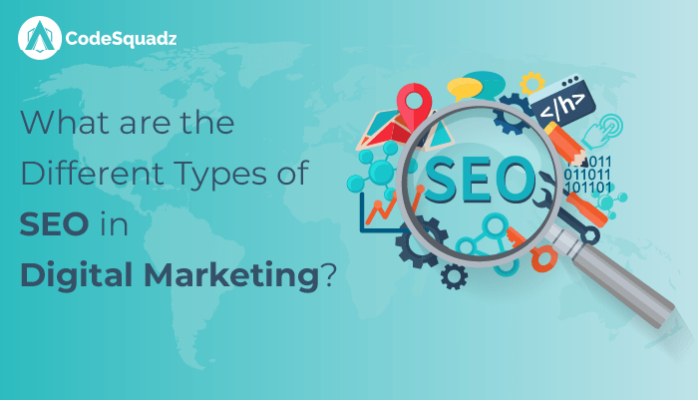Search Engine Optimization (SEO) is all about optimizing your website to help search engines understand and present your content to the correct audience. It increases the visibility of your website to organically generate traffic. It is the art of getting your website and web pages to rank higher on the search engine result pages (SERPs).
Almost every business has shifted from traditional marketing to online or digital marketing. The worth of the SEO industry is USD 80 Bn which shows the significance of SEO in digital marketing for every business.
Therefore, more job aspirants choose digital marketing as a career. For this, it is recommended that they follow the latest trends in digital marketing. It is the fastest-growing career in today’s digital age. Higher website rank on SERP is a key role of SEO because 75% of people search for answers to their query on the first page of the search engine.
11 Types of SEO in digital marketing
There are 11 major types of SEO in digital marketing and below is its list with descriptions.
1. White-Hat SEO
SEO practice to boost the rank of a website on SERP by staying within the terms & conditions of a search engine. Here, an SEO professional should always comply with the guidelines set by search engines, especially Google (a major search engine). White-hat SEO practice is considered to be the best and the safest SEO practice.
These SEO tactics are crucial to be in the good books of search engines. A few of the core examples of a White-hat SEO are given below.
- Make the website content-rich with the use of relevant keywords.
- Give descriptive meta-description of a website or web page.
- Don’t forget to make a website user-friendly with easy navigation.
- Always prioritize on-page optimization of a website or web page.
2. Black-Hat SEO
Ranking higher on the website using practices violating the search engine guidelines. It is the practice of exploiting a weakness of a search engine like Google to push the rank of a website. This is a temporary game-changing technique for an SEO professional. However, it can damage the online presence of a website, especially if this wrong SEO technique is followed for a longer time.
Although, many SEO professionals use this technique to get instant results. Here are examples of this shady SEO technique.
- Using paid backlinks strategy
- Keyword stuffing
- Sneaky redirects
- Poor or irrelevant quality content
- Addition of irrelevant keywords to a content
3. Negative SEO
Today, one of the unethical ways to rank higher on a search engine is the use of negative SEO. This SEO type is aimed to lower the competitor’s search ranking. It is a popular type of Black-hat SEO as it makes an SEO professional create a huge amount of low-quality links to a website. Moreover, it also includes publishing negative reviews on various online platforms to downgrade the online reputation management of a business.
4. Gray-Hat SEO
A combination of White-hat and Black-hat SEO is known as Gray-hat SEO. It is one of the most unhelpful SEO practices which is riskier to do compared to the White-hat SEO. At the same time, it is a much safer practice when compared with the Black-hat SEO practices. Implementing the Gray-hat SEO practice doesn’t lead to the banning of a website by the search engine.
Here, the content (text or multimedia content) using this SEO practice is not defined. With this technique, an SEO professional ensures that there is minimal or no loss in website traffic.
- Using auto-generated or AI-generated content
- Applying duplicate content or spinning content
- Paying to get good reviews
- Link exchange
5. On-Page SEO
On-page or on-site SEO is the practice of optimizing the website elements to improve its ranking on SERPs. Increasing relevant traffic is one of the key roles of this SEO practice. In this, an SEO professional focuses on using relevant keywords and content to give people what they are looking for. Below are the most helpful factors regarding on-page SEO.
- Keyword Research: SEO professional identifies relevant search terms and incorporates those search terms or keywords in the website’s content.
- Title Tag and Meta Description: A short version of a web page title in less than 60 characters with a main keyword in the title tag. Whereas, A short summary of a web page in 160 or fewer characters is its meta description.
- Image Optimization: It is the process of optimizing the website images with Alt text and captions. This improves the UX and conveys a clear message to search engines.
- URL Structure & Interlinking: Attempt to improve your website ranking by designing and organizing URLs by using relevant keywords in them. Moreover, you need to use interlinking properly by inserting links to redirect traffic on different web pages.
6. Off-Page SEO
Off-page SEO (also known as off-site SEO) is no more than the publicity of a website on a search engine. It is a practice of elevating website ranking through optimization factors outside the website. Through this, an SEO professional tells search engines that a particular website is trustworthy. This off-page SEO helps to drive more traffic to a website to improve the website ranking. Below are the tactics regarding off-page SEO.
- Backlinks: When some websites with a great domain authority (DA) interlink with your website, it acts perfectly to improve the DA of your own website. Here, guest blogging, profile creation, image submission, and classifieds are everyday off-page activities for building backlinks.
- Online Reviews: Formulate a special strategy to collect customer testimonials on your Google business profile.
- Brand Signal: It refers to the online presence of a brand established through social media engagement and directory listings.
7. Technical SEO
Technical SEO is the practice of optimizing a website to enable search engines to easily crawl and index a website. Many technical aspects are covered to optimize a website and push its rank higher in SERP. A goal here is to make a website more effective to run on multiple devices. The following are the crucial factors of Technical SEO.
- Increase Site Loading Time: Increase the speed of a website to work on different devices to give a better user experience (UX).
- Mobile-Friendly: Making a site mobile-friendly is designing a website for viewing on a mobile device. More than 4.32 Bn active internet mobile users are available making mobile-friendliness an important factor.
- Website Audit: A great way to ascertain any anomaly in a website is by doing a website audit. It helps to identify any problem with the website. Content audits and keyword cannibalization audits are common audits for technical SEO.
- Site Structure: Create a sitemap (XML and HTML) with an organized website structure to enable both people and search engines to understand a website.
8. Local SEO
It is one of the best strategies for businesses to have a physical store. This SEO helps local audiences connect with a business by analyzing billions of search queries. It boosts local businesses to get their website to rank higher in the search results of local maps. This is another great way to have huge traffic to your website.
With local SEO tactics, a business can present itself in location searches. Following are some of the common local SEO tactics.
- Placing your contact details like phone number and address on all web pages.
- Don’t forget to maintain your Google business profile with all the necessary details.
- Business listings and location directories also help in Local SEO.
9. E-Commerce SEO
E-Commerce SEO is one of the popular marketing techniques to have more traffic on your eCommerce website. It costs much less than paid traffic. If you have an online store, then this SEO practice is essential for you. An online store remains higher in search results whenever anyone searches for a specific product online.
Avoiding E-Commerce SEO for your website may lead to the loss of crucial assets and potential customers. As an SEO professional, you should focus more on the homepage structure and website navigability. It increases website traffic, search volumes, and business ROI.
10. Content SEO
Another type of SEO in digital marketing is Content SEO which is the practice of creating unique content. This SEO type focuses on the development of unique content for the website. From image alt text to web page content, everything is considered while doing content SEO. Creating original content and a meticulous keyword strategy play a key role in this type of SEO.
Anyone can master Content SEO or any other types of SEO from the digital marketing training program of CodeSquadz. Here, checking the content quality before and after publishing content on the website is important. Moreover, modifying the content according to its performance is also important when it comes to Content SEO.
11. Mobile SEO
Mobile SEO is the practice of optimizing your website for its operation on mobile devices. An SEO professional adopts this to make its website function on devices like mobiles and tablets. Nowadays, almost every website is mobile friendly as a customer can bounce to any other website on facing a bad experience while using its mobile device.
Conclusion
Search engine optimization (SEO) is crucial to improve a website’s rank and increase its organic traffic. In this ever-evolving world of digital marketing, every SEO professional should be aware of all the types of SEO to commence their career in digital marketing. Using SEO correctly helps a business achieve desired results by driving targeted audiences to its website.







